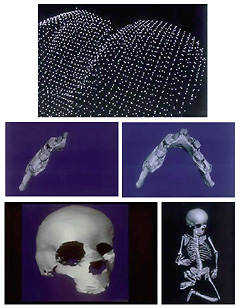
Click on the image to enlarge it. |
Computer reconstruction of the first Dederiyeh Neanderthal child.
In order to achieve a full reconstruction of the child, the complete skeleton was necessary. ALThough the preservation was very good, there were nevertheless some parts that were missing or broken. As well as this problem, there was the question of how to assemble an ideal, scientifically-based skeleton. This project used computer technology to search for the best skeletal form. Computer science also played an invaluable role in study of the locomotion and growth patterns of the completed skeleton. |
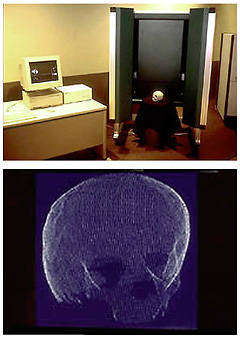
Click on the image to enlarge it. |
3-D shape measuring apparatus.
This apparatus was used to measure each of the child's bones. A laser beam is shone onto the surface of the bone; from the reflection, the coordinates of this bone are triangulated and automatically input into the computer as digital values. The digital data measured by the apparatus can be used to display the skeleton, but at this stage the image is still a rather amorphous collection of dots. |
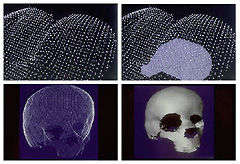
Click on the image to enlarge it. |
Processing the 3-D data.
The data has still to be processed by joining the dots to produce the surface and shading of the object (compiled from Suzuki et al., 2003: Figs. XV-5~10). |
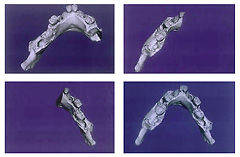
Click on the image to enlarge it. |
Applying the processed data.
A complete skeleton cannot be made with some parts broken or missing, but using the 3-D data it is easily possible to reconstruct such parts by the inverse reproduction of bones from the opposite side of the body (modified from Suzuki et al., 2003: Plate XV-1). |
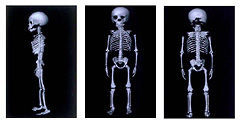
Click on the image to enlarge it. |
The fully assembled skeleton of the first Dederiyeh child.
The computerized data can be freely used to arrange the curve of the spine, the gaps between the bones and other features using modern skeletons and plastinations for reference. |
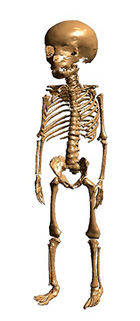
Click on the image to enlarge it. |
Computer reconstruction of the first Dederiyeh Neanderthal child (Dederiyeh 1).
(From Akazawa and Muhesen (eds.), 2003: Frontispiece 12.) |
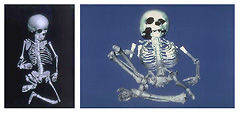
Click on the image to enlarge it. |
The burial position of the first Dederiyeh child.
The computerized skeleton can be moved and repositioned as required. In addition to the reconstructed burial position shown here, various other body angles are possible. |
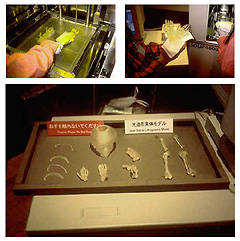
Click on the image to enlarge it. |
Making a model of the Dederiyeh child using laser stereolithography.
An apparatus which makes 3-D models with a liquid resin which hardens when exposed to a laser beam. Together with the 3-D shape measuring apparatus, this is a cutting-edge technology which played an important role in the current project. Using the coordinates of each bone stored in the computer, the laser is shone onto a light-sensitive epoxy resin inside the apparatus. This resin then hardens, producing -- after the process is repeated many times -- an actual model of the bone A model of the Dederiyeh child could not be made using the actual bones and replicas were therefore necessary. In order to make these replicas it was decided to attempt a new experiment using the data on the skeleton stored in the computer. Laser stereolithography can not only automatically produce as many copies as necessary, but can also be used to reproduce missing or broken parts and to freely model the final product. |
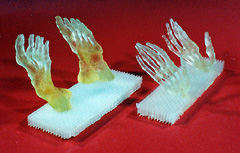
Click on the image to enlarge it. |
Models of the Dederiyeh child using laser stereolithography.
(From Suzuki et al., 2003: Fig. XV-16.) |

Click on the image to enlarge it. |
Locomotive reconstruction of the first Dederiyeh child (Dedriyeh 1).
The locomotive pattern of the child is shown using a computerized 3-D representation of its skeleton. The Dederiyeh child has an estimated pace length of 0.32 m and a rate of walking of 1.06 m per second. This walking behaviour is very similar to that of a modern two-year-old child. Despite differences in body proportions, such as the large head, long arms and thick bones, the Dederiyeh child would have walked with almost the same posture as a modern infant. |
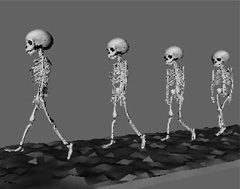
Click on the image to enlarge it. |
Locomotive reconstruction of the first Dederiyeh child (Dedriyeh 1).
(From Akazawa and Muhesen (eds.), 2003: Frontispiece 13.) |
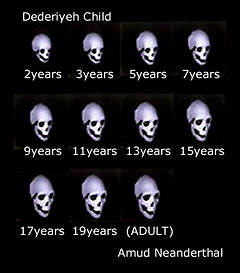
Click on the image to enlarge it. |
Reconstructing the growth of the face and skull of the Dederiyeh child.
Assuming that the Dederiyeh child had continued to live, we tried to estimate how the shape of its face would have changed with age. The face of a Neanderthal adult was quite different from that of modern humans. The most distinctive characteristic of the former is a rim-like protuberance above the eye sockets, but other features include a large and robust nose and lower jaw, and, when compared with modern humans, a long, narrow brain case.
Assuming that the Dederiyeh child would have developed a face similar to that of Amud Man (a contemporary West Asian adult Neanderthal), reconstructions were made of how the face might have changed with age. Modern children have an age when they rapidly develop adult features, but from age 15 the Dederiyeh child seems to have changed even more than his or her modern counterparts, especially around the craniofacial skeleton, and appears to have quite suddenly developed a Neanderthal-like face (modified from Kouchi and Mochimaru, 2003: Fig. XIV-4). |
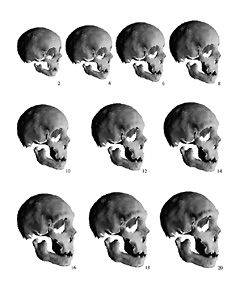
Click on the image to enlarge it. |
Model simulation of the growth of the face and skull of the first Dederiyeh child (Dederiyeh 1).
(Age in years.) (From Suzuki et al., 2003: Plate XV-2.) | |












